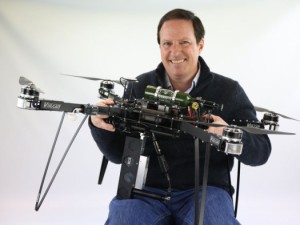By Ria Sandhu
Deforestation is a growing concern when it comes to climate change because rising carbon dioxide levels and burning trees damage the atmosphere. The rate at which trees are being planted is not fast enough to combat industrial deforestation.
BioCarbon Engineering, an emerging new company based in Oxford, is taking advantage of drone technology and using modified UAVs to combat deforestation and global climate change. They have found an innovative way to use drones for planting trees more efficiently.
Lauren Fletcher, the CEO of BioCarbon Engineering, tackles this issue by focusing on the idea of rapid reforestation. The company’s mission statement says, “We are going to counter industrial scale deforestation using industrial scale reforestation.”
Currently, the process of planting trees by hand takes a lot of manual labor and time. The alternative is to spread dry seeds by air, but there is usually not enough “uptake” when using this method. However, Fletcher and his team of engineers have found a way to reduce the cost and manpower needed to plant more trees. By incorporating drone technology with sensors and planting technology, BioCarbon Engineering is developing a new way to increase the rate at which trees can be successfully planted and monitored, initiating rapid reforestation.
Fletcher has a PhD in Physics, an M.S. in Civil and Environmental Engineering, and 20 years of engineering experience working for NASA. In his promotional video, he has set the goal of planting one billion trees a year using his company’s new drone technology. His drone will provide access to remote and previously inaccessible areas in places like Brazil, where deforestation has destroyed parts of the Amazon Rainforest. It will also have the technology to 3D map the land it flies over.
In their video, the company mentions how they will use planting technologies to develop seedpods that will then be combined with sensor-modified UAVS, initiating the process of precision forestry. Precision forestry is the idea of using 3D mapping, sensors, and other technology to improve forest planting techniques and increase the efficiency of the planting route for the drone to follow.
In an interview with WIRED.co.uk, Fletcher says, “I’d been following trends on drones for the last five years. Global deforestation is happening at an industrial scale. Governments and organizations are spending billions planting trees, but the standard method of hand-planting can’t keep up.” This new method of precision forestry is the solution and it may be the future of farming and agriculture as well.
Fletcher’s technology gained some recognition when his company managed to reach the semi-final stage of the Drones for Good competition in Dubai.
The company has divided their project into two major phases:
- Phase I involves gathering detailed terrain data to produce 3D maps of land that needs to be restored. This would give them a detailed visual model of the area and make it easier to plan out routes for the drone to follow.
- Phase II involves using modified planting UAV’s to carry out precision planting activities. The drones would plant seeds in a specific predetermined pattern that is programmed into their flight path.
As described in their video, the company will develop biodegradable nutrient seedpods that are filled with nutrient rich gel (to reduce impact) and germinated seeds. The seedpods will be released (1-2 meters from the ground) using the propulsive force of a small, pressurized air canister that will be attached to the UAVs.The seeds will break open upon impact and the planting process will begin.
For this innovation, the company won the Skoll Centre Venture Award. As well as providing a way to transport seeds, the UAVs can actively monitor ecosystem health overtime, landscape design, and planting patterns, helping environmentalists plan out future planting routes in precision forestry.
As Mistbreaker News reports, Fletcher’s drone would allow two people to remotely control and plant roughly 36,000 trees every day. As a comparison, the article mentions, “Kenya NGO plants 200 trees per day, while highly trained personnel in Canada can plant about 1600 trees per day.”
When looking at these numbers, BioCarbon Engineering drone technology will increase the efficiency and reduce the cost by a significant amount. The company is currently partnered with VulcanUAV, Oxford Product Design, and Skoll Foundation.
As reported by WIRED.co.uk, Fletcher and his company are currently collaborating with an environmental, non-governmental organization called Imozen to start work in the Amazon. Brazil is a good place to start using their drone technology because deforestation has damaged a large chunk of the Amazon Rainforest. But expanding to other countries might prove difficult when it comes to regulations and laws against drones.
Martin Tengler, a team member and policy coordinator of Biocarbon Engineering, says “For the moment, we plan to operate in Brazil, where the legal conditions are better than in the US. But we believe the US will update its legislation in the near future to something that would favor our business model there as well.” The FAA has definitely been an obstacle for many companies when it comes to operating in the US. But this company is focusing on developing countries where deforestation rate is highest and regulations on drone use is minimal.
Other than the seed cannon, various sensors, and mapping technology, the company has not considered any other modifications to their drone yet. Since the drone will be flying in deforested areas, it will not encounter many obstacles, so making the drone collision proof is not a concern. It would also add weight and create engineering challenges.
Overall, BioCarbon Engineering has found a new and creative way to solve a major global issue. Their tree-planting drone will change the future by obliterating the harmful effects of deforestation and giving rise to the new method of precision forestry.
Fletcher’s drone following a pre-determined planting path
Lauren Fletcher, CEO of BioCarbon Engineering


